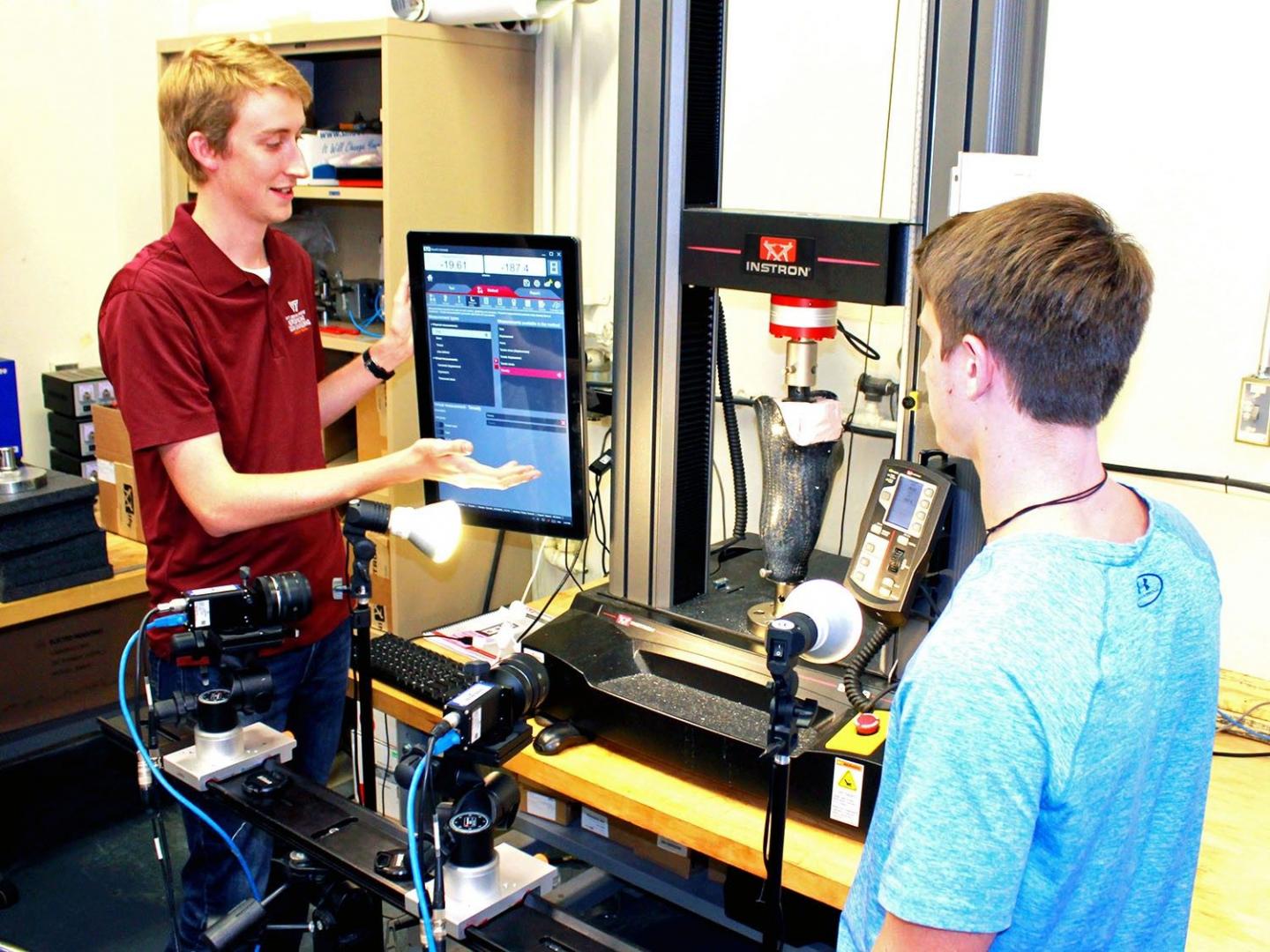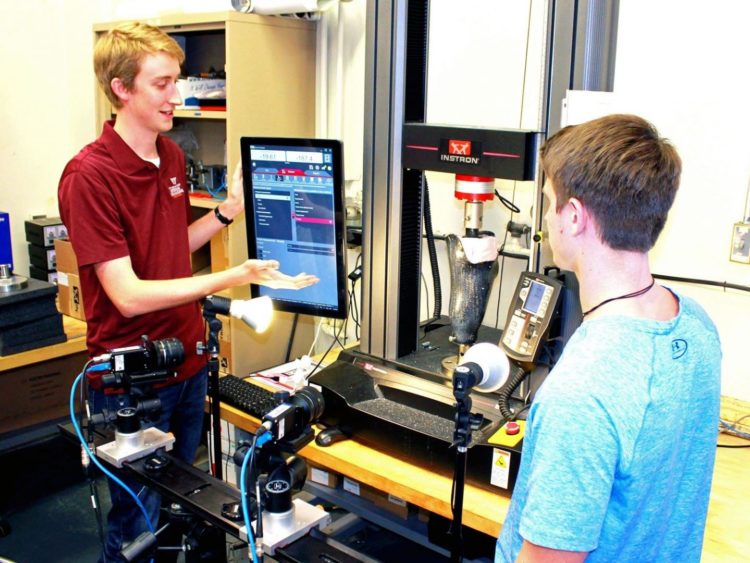
Credit: Virginia Tech
As a physically active college student Trevor LeMaster is no stranger to bodily aches and pains. He is a runner and a former high school wrestler who experiences soreness and workout injuries. LeMaster is also a transfemoral amputee and has first-hand knowledge of the impacts the fit of his prosthetic device has on his residual limb.
LeMaster experienced fluctuations in weight in and out of his wrestling season. At a smaller weight, his residual limb was much smaller in size. Once he gained weight when out of season, LeMaster found he needed to tightly wrap his limb at night and elevate it while sleeping just to get his prosthesis on in the morning.
Individuals with a transfemoral amputation, which is above the knee, or a transtibial amputation, which is below the knee, unavoidably find that throughout the course of the day, fit and comfort of their prosthetic device degrades due to volume loss in the residual limb. A number of factors can contribute to this loss, including the amount of physical activity, hydration levels, and fluctuations in weight. This volume loss can lead to pain, skin irritations, and soft tissue injuries and reduce the individual’s quality of life.
With a $400,000 grant from the National Science Foundation, Virginia Tech College of Engineering researchers will study volume loss and develop smart prosthetic sockets to improve comfort and performance in prostheses.
Associate Professor Michael Philen of the Kevin T. Crofton Department of Aerospace and Ocean Engineering and Professor Michael Madigan of the Grado Department of Industrial and Systems Engineering are teaming up to combine their respective expertise in smart materials and biomechanics. They will work to develop new prosthesis technology that provides a higher level of comfort and mobility for the wearer.
In addition, the team is collaborating with Brian Kaluf of Ability Prosthetics and Orthotics in Charlotte, North Carolina, a certified and licensed prosthesis fabrication and clinical servicing facility.
“Mike Madigan and I saw this as a great opportunity to take technology I’ve been working with and combine it with his work in biomechanics,” said Philen. “We’ve worked together for a number of years advising engineering teams that focus their capstone design projects on prosthetic and orthotic devices. This work could be a viable solution for those affected by volume loss in the limb and offer a better overall quality of life.”
The research team includes Destiny Mason, Michael Philen, Trevor LeMaster, Michael Madigan, and Carson Squibb.
The research team includes aerospace engineering sophomore Destiny Mason, Associate Professor Michael Philen, mechanical engineering junior Trevor LeMaster (front), Professor Michael Madigan, and aerospace engineering Ph.D. candidate Carson Squibb.
Over the course of the three year grant from the National Science Foundation, Philen, Madigan, and their team of students will be developing new techniques to accurately measure the volume change and limb deformation throughout the day, as well as the changes in the fit of the prosthetic socket itself.
Philen’s work in the Aerospace Structures and Materials Laboratory includes a technology known as fluidic flexible matrix composites. These composites already have been demonstrated in aerospace structures, morphing structures, robotics, and wave energy conversion systems.
In turn, Madigan’s Biomechanics Group brings expertise and experience studying the dynamics of human movement, including the day-to-day challenges we all face related to gait, balance, and slip, trip, and fall prevention.
When integrated into a prosthesis, fluidic flexible matrix composites can accommodate to limb volume loss, and help maintain a comfortable fit for the user.
LeMaster, a junior majoring in mechanical engineering, was introduced to Philen and Madigan and is now working on the research team as an undergraduate research assistant. He is eager to bring his unique perspective to the team and learn more about the design process of prosthetics through his undergraduate research.
“This project will give amputees more control over their prosthetic sockets, and they will be able to recognize when their limb is slimming down throughout the day,” said LeMaster, who is also a member of the mechanical engineering department’s biomedical engineering design team BioActivity. “This smart socket would allow amputees to change the volume of their socket as their limb shrinks in volume throughout the day, giving them more support and comfort.”
For a young, active person like LeMaster, it is not uncommon to have more than one prosthesis, with one model for everyday use and another for physical activity, such as running. With a running prosthesis, the socket needs to have a much tighter fit due to the type of force and pressure put on the limb during activity.
Typically the fit of a prosthesis can be adjusted, generally by adding or removing compression socks, until the fit is comfortable. As the day progresses, there is volume loss in the limb and certain areas bear much more of the pressure and weight, resulting in pain and discomfort. There are several prosthetic systems on the market that try to address this, but each system has their limitations and there is not one best solution for everyone.
Throughout the course of the project, the research team aims to track strains (i.e. deformation) on the residual limb during daily activities using digital image correlation and a clear diagnostic socket.
Digital image correlation is an established technique for acquiring 3D strains and displacements on the surface of materials, and applying to socket fit will provide new insights into the relationship between strain and comfort. Additionally, they are developing a high precision laser scanning system that will be able to measure the shape and volume of the limb before and after completing the physical activities.
Once the team has a better understanding of residual limb deformation during active use, the researchers will work on developing a smart prosthetic socket employing fluidic flexible matrix composite technology. Wafers made of fluidic flexible matrix composite integrated into the smart socket can achieve an increase in volume when pressurized, exhibit changes in stiffness, and can be fabricated into a variety of shapes and configurations that can be tailored specifically for the user.
Currently LeMaster does not have a lot of issues with severe pain as he has opted to wear a larger sized socket. He still needs to use additional compression socks for a better fit, but it is more cumbersome to put on.
“I’ve never heard of a volume changing socket like this one,” said LeMaster. “I think it’s a really unique idea that has the potential to be very impactful.”
###
Media Contact
Lindsey Haugh
[email protected]
540-231-2476
Original Source
https:/





